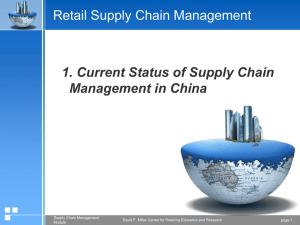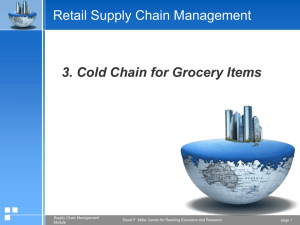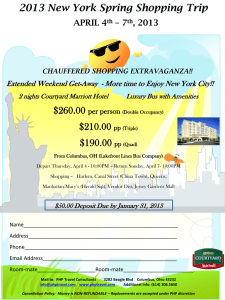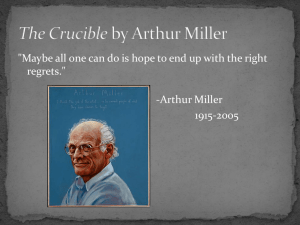Slide 1
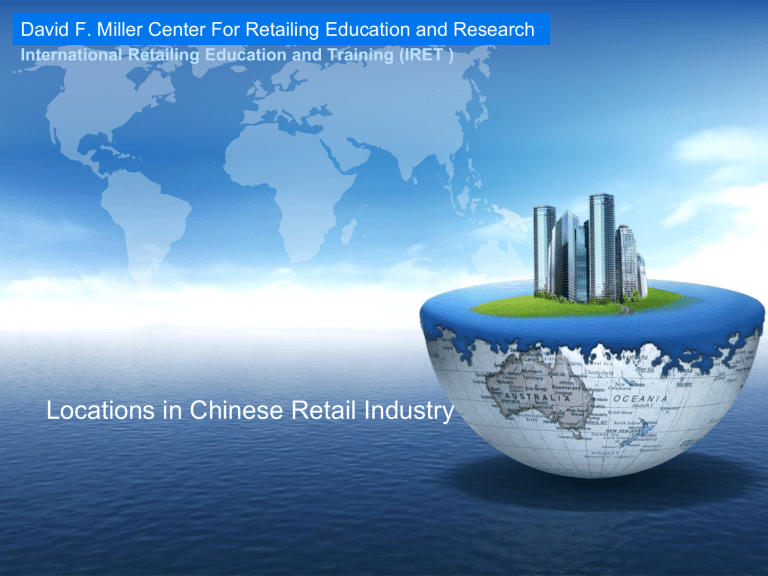
David F. Miller Center For Retailing Education and Research
International Retailing Education and Training (IRET )
Locations in Chinese Retail Industry
David F. Miller Center For Retailing Education and Research
International Retailing Education and Training (IRET )
Segment 1 Types of Locations
Segment 1: Types of Locations
Learning Objectives:
Know about major location segmentations and how to match different location characteristics with retail types
Learning Contents:
Location definition and major location segmentations
Central Place Theory
Matching location segmentations with retail types
Lifestyle segmentation in China
Location Module David F. Miller Center for Retailing Education and Research page 3
3 Types of Locations
Location Module
Isolated
Store
Unplanned
Business
District
Planned
Shopping
Center
David F. Miller Center for Retailing Education and Research page 4
Isolated Store
Freestanding retail outlet located on either a highway or a street.
There are no adjacent retailers with which this type of store shares traffic.
Examples:
Large-store formats
Wal-Mart
Carrefour
Convenience stores
7-Eleven
Location Module David F. Miller Center for Retailing Education and Research page 5
Isolated Stores
Free Standing:
No adjacent retailers with which this type of store shares traffic.
Location Module David F. Miller Center for Retailing Education and Research page 6
Isolated Stores
Advantages
* No competition
* Low rental costs
* Flexibility
* Good for convenience stores
* Better visibility
* Adaptable facilities
* Easy parking
Disadvantages
* Difficulty attracting customers
* Travel distance
* Lack of variety for customers
* High advertising expenses
* No cost sharing
* Restrictive zoning laws
David F. Miller Center for Retailing Education and Research Location Module page 7
Unplanned Business Districts
Type of retail location where two or more stores situate together (or nearby) in such a way that the total arrangement or mix of stores is not due to prior longrange planning.
Central Business
District
Secondary
Business
District
Neighborhood
Business
District
String
District
David F. Miller Center for Retailing Education and Research Location Module page 8
Unplanned Business Districts
Central business district (CBD):
Hub of retailing in a city. The CBD has the greatest density of office buildings and stores.
Secondary business district (SBD):
Usually bounded by the intersection of two major streets.
It has at least a junior department store and/or some larger specialty stores - in addition to many smaller stores.
Location Module David F. Miller Center for Retailing Education and Research page 9
Unplanned Business Districts
Neighborhood business district (NBD):
Appeals to the convenience shopping and service needs of a single residential area. The leading retailer is typically a supermarket, a large drugstore, or a variety store and it is situated on the major street(s) of its residential area.
Location Module David F. Miller Center for Retailing Education and Research page 10
Unplanned Business Districts
String:
A group of retail stores, often with similar or compatible product lines, located along a street or highway.
Location Module David F. Miller Center for Retailing Education and Research page 11
Unplanned Business Districts
Advantages
* Excellent goods/service assortment
* Access to public transportation
* Variety of store types and positioning strategies within one area
* Wide range of prices
* Variety of customer services
* High level of pedestrian traffic
* Near commercial and social facilities
Disadvantages
* Inadequate parking
* Traffic and delivery congestion
* Travel time for those living in the suburbs
* Many aging retail facilities
* Declining condition of some central cities
* Poor image of central cities to some consumers
* High rents and taxes for popular sites
* Movement of popular stores to suburban shopping centers
* Discontinuity of offerings
David F. Miller Center for Retailing Education and Research Location Module page 12
Planned Shopping Centers
Group of architecturally unified commercial facilities on a site that is centrally owned or managed, designed and operated as a unit, based on balanced tenancy, and accompanied by parking.
Regional
Shopping
Center
Community
Shopping
Center
Neighborhood
Shopping Center
David F. Miller Center for Retailing Education and Research Location Module page 13
Planned Shopping Centers
Community shopping center:
Moderate-sized shopping facility with a branch department store and/or a category killer store, in addition to several smaller stores.
Regional shopping center:
Large shopping facility appealing to a geographically dispersed market. It has at least one or two full-sized department stores and 50 to 150 or more smaller retailers.
Factory outlets center:
Sells high-end discounted foreign-branded apparel, furniture, electronics and other specialty items, most consumers tend to go to traditional department store or a wholesale market.
David F. Miller Center for Retailing Education and Research Location Module page 14
Planned Shopping Centers
Advantages Disadvantages
* Well-rounded assortments
* Strong suburban population
* Higher rent
* One-stop, family shopping
* Limited flexibility
* Restrictions on offerings
* Competitive environment
* Cost sharing
* Transportation access
* Requirements for association memberships
* Too many malls
* Pedestrian traffic
* Domination by anchor stores
Location Module David F. Miller Center for Retailing Education and Research page 15
Large Mega Mall in China
South China Mall in Dongguan, China
One of the world’s largest shopping mall, arrayed in size separate themed areas.
9.6 million total square area
1,500 stores
Location Module David F. Miller Center for Retailing Education and Research page 16
Retail Locations Comparison U.S. versus China
Location Types
Free standing
Merchandise kiosks
CBD/NBD
Main street/strings
Inner city
Power centers
Shopping malls
Lifestyle centers
Fashion/specialty
Factory outlet
Theme festival centers
Open air market
Location Module
China
X
X
X
X
Very Few
X
David F. Miller Center for Retailing Education and Research
X
X
X
X
X
X
US
X
X
X
X
X
Very Few page 17
Retail Locations Comparison U.S. versus China
Open air market in China
Free standing in China
Free standing in the U.S.
Location Module
Lifestyle center in the U.S.
David F. Miller Center for Retailing Education and Research page 18
Location Segmentation in China
Locations
Free Standing
CBD
SBD
NBD
String
Community
Shopping Center
Regional
Shopping Center
Retail Types (example)
Any retail type
Department stores, convenient stores and restaurants
Department stores, convenient stores, grocery stores, and restaurants
Supermarkets, pharmacies, barber shops and restaurants
Department stores and restaurants
Supermarkets, pharmacies and home goods
Supermarkets, pharmacies, home goods and clothing stores
Factory Outlets Branded goods
Location Module David F. Miller Center for Retailing Education and Research page 19
Other Retail Formats in China
Wet Market
informal commercial sections that sell fresh fruits and vegetables.
Vendors gather together to create a central place.
Prices here are lower than in supermarkets of department stores.
Products are not refrigerated.
Location Module David F. Miller Center for Retailing Education and Research page 20
Other Retail Formats in China
Open Air Market
Sells a variety of merchandise.
The area is usually covered with a roof but with only a small metal cage around the vendors.
Bargaining is common in open air markets.
Location Module David F. Miller Center for Retailing Education and Research page 21
Other Retail Formats in China
Exotic Market
Also major shopping centers and shopping districts with full-scale department stores.
Carry designer brands, regular national brands, and private label merchandise, all of which are sold at a fixed price.
Location Module David F. Miller Center for Retailing Education and Research page 22
Other Retail Formats in China
Hypermarkets
In 1999, the number of hypermarkets was less than 100 in China, however, since that time there has been an explosion of this format.
Many domestic firms opened hypermarkets only to find that they could not match the competitive muscle of the foreign companies like Wal-Mart and Carrefour. As a result most of the domestic hypermarket businesses have closed, leaving the foreign competitors alone to fight it out.
Foreign retailers in China have focused on hypermarkets formats because they can forego the initial investment in distribution centers.
Location Module David F. Miller Center for Retailing Education and Research page 23
Retail Type Classification in China
Below is the list of retail type classification from the Chinese Retail Industry website:
Location Module David F. Miller Center for Retailing Education and Research page 24
Central Place Theory
Central Place Theory:
A spatial theory that explains the reasoning behind the distribution patterns, size and number of central places around the world
Assumes the bigger size of central place is the more distant consumers will be attracted to the central place, as well as the boarder range of goods and services it provides.
Location Module David F. Miller Center for Retailing Education and Research page 25
Central Place Theory
Location Module David F. Miller Center for Retailing Education and Research page 26
Central Place Theory- China
Settlement system in Zhejiang, China
The hexagon represents a town in the Zhejiang
Province of China
Location Module David F. Miller Center for Retailing Education and Research page 27
Central Place Theory Example
Example: A string in Guangzhou, China
This is an example of the “group effect” in the central place theory where similar stores are clustered together.
David F. Miller Center for Retailing Education and Research Location Module page 28
Central Place Theory Example
Example: A string in Hong Kong.
Similar stores are located near one another so consumers can easily compare prices and quality
David F. Miller Center for Retailing Education and Research Location Module page 29

